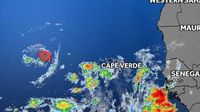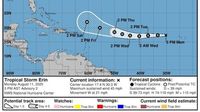Tropical Storm Erin, the fifth named storm of the 2025 Atlantic hurricane season, has rapidly become the center of attention for meteorologists and coastal communities alike. Forming early Monday morning, August 11, 2025, as it pulled away from the Cabo Verde Islands in the far eastern Atlantic, Erin’s emergence marks a pivotal moment in what has already been an active season. According to the National Hurricane Center, Erin is forecast to become the first hurricane of the 2025 season by Thursday, August 14, and could further intensify into the first major hurricane of the year by the upcoming weekend.
In its initial hours, Erin tracked westward at a steady pace, with the National Hurricane Center reporting movement at around 20 mph. By 5 a.m. Tuesday, August 12, the storm’s speed had increased slightly to 22 mph, and it was positioned approximately 590 miles west-northwest of the Cabo Verde Islands and about 1,890 miles east of the Northern Leeward Islands, as detailed by Gulf Coast News. Maximum sustained winds reached 45 mph, and the storm’s minimum central pressure was measured at 1004 mb. Despite its growing strength, there were no coastal watches or warnings in effect as of Tuesday morning.
For now, Erin remains over relatively cool waters, which will likely limit its intensification through the next 24 to 48 hours. However, forecasters agree that by midweek, the storm will encounter much warmer waters and lower wind shear—ideal conditions for rapid strengthening. As the Tampa Bay Times noted in a Monday update, the National Hurricane Center expects Erin to become a hurricane as it continues its westward journey through the Atlantic.
Computer models and meteorological guidance consistently project Erin’s path to remain over open waters for at least the next five days. The consensus among many forecasting models is that Erin will eventually begin a slow turn toward the west-northwest by the weekend, passing north of the Leeward Islands on Saturday, August 16. This classic “recurve” scenario, as described by several outlets, would keep the storm away from the Caribbean and potentially the U.S. mainland.
Yet, there’s a twist. While most models favor this northward turn, there remains significant uncertainty about exactly when and where Erin will make its move. A key factor, as highlighted by multiple meteorologists, is the storm’s near-term strength. If Erin intensifies quickly, it’s more likely to feel the pull of steering currents and curve north earlier, sparing land areas. On the other hand, if it remains weaker for longer, it could travel farther west before turning, which might increase the risk of a closer approach to land.
The European model, in particular, has suggested a more worrisome scenario, hinting that Erin could brush the Outer Banks of North Carolina before finally curving away from the coast. This divergence in model guidance underscores the need for continued vigilance, as even minor changes in the storm’s strength or the positioning of high-pressure systems could alter its trajectory and potential impacts.
“The key factor will be Erin’s strength in the near term,” one meteorologist explained. “If it intensifies quickly, it’s more likely to feel the pull of the steering currents and curve north. But if it remains weaker for longer, it could travel farther west before turning — increasing the chance of getting closer to land.”
For now, the forecast trend remains for Erin to turn north by the end of the weekend or early next week, as a high-pressure area to the north shifts eastward. Should this play out, the storm would stay north of the Caribbean and likely turn before reaching the Bahamas, keeping it away from the United States. Nonetheless, the National Hurricane Center and local weather teams are urging residents along the East Coast and in Bermuda to keep a close eye on updates, as the timing and location of the northward turn remain uncertain.
As of Tuesday, August 12, Erin was still expected to remain over open waters, with no immediate threats to land. The Gulf Coast News Hurricane Tracking team emphasized that the storm was “forecast to stay over open waters for the next 5 days,” but also cautioned that “the trends bear watching closely over the next several days.” The Atlantic hurricane season, which runs from June 1 through November 30, is notorious for its unpredictability, and Erin’s development is a timely reminder of the importance of preparedness.
Meanwhile, other areas of the Atlantic are also being monitored by the National Hurricane Center, which is currently tracking three different systems. While Erin has captured the spotlight due to its potential to become a major hurricane, meteorologists stress that the broader environment remains conducive to tropical development as the season approaches its peak.
Communities along the U.S. East Coast, as well as in the Caribbean and Bermuda, are being advised to review their hurricane preparedness plans and ensure that supplies are in order. Even though the forecast models currently favor a path that keeps Erin away from land, the inherent uncertainty in long-range hurricane forecasting means that a change in the storm’s behavior could quickly alter the risk profile for coastal areas.
In Florida, for example, meteorologists have been clear that it is “too soon to tell what, if any, impacts Florida might see.” The Gulf Coast News and WESH 2 both highlighted the importance of staying informed through official channels and local weather teams, who are committed to providing the most accurate and up-to-date information as the situation evolves.
Elsewhere, parts of coastal Pinellas County received up to 8 inches of rain on Sunday night, August 10, from a separate weather system, illustrating the multiple hazards that can arise during hurricane season. While Erin currently poses no direct threat to land, the broader context of an active Atlantic underscores the need for vigilance across the region.
As the week unfolds, all eyes will remain on Tropical Storm Erin as it races westward, poised to become the season’s first hurricane—and possibly its first major hurricane—by the weekend. With the storm’s future path still uncertain, the coming days will be critical for monitoring updates and preparing for any changes that may arise.
For now, Erin’s journey across the Atlantic serves as a stark reminder of the power and unpredictability of nature, and the importance of readiness as hurricane season enters its most active phase.


